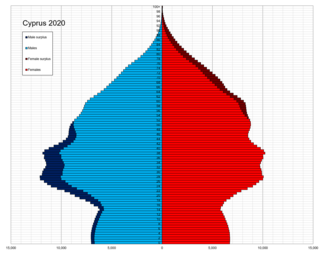
The people of Cyprus are broadly divided into two main ethnic communities, Greek Cypriots and Turkish Cypriots, who share many cultural traits but maintain distinct identities based on ethnicity, religion, language, and close ties with Greece and Turkey respectively. Before the dispute started in 1964 the peoples of Cyprus were dispersed over the entire island.

This article is about the demographic features of the population of Denmark, including ethnicity, education level, health of the populace, economic status, religious affiliations, and other aspects of the population.

The population of Indonesia was 270.20 million according to the 2020 national census, an increase from 237.64 in 2010. Approximately 55% of Indonesia's population resides on Java, which is the most populous island in the world.

This article is about the demographic features of the population of Macau, including population density, ethnicity, education level, health of the populace, economic status, religious affiliations and other aspects of the population.
This article concerns the demography of Réunion. People of Réunion are Réunionese. The official language is French, and Réunionese Creole is widely spoken. The population of Réunion is 966,129 as of 2021.
This article is about the demographics of the population of Saint Kitts and Nevis including population density, ethnicity, religious affiliations and other aspects of the population.
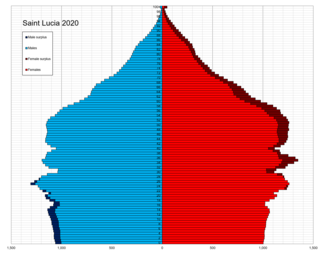
This is a demography of the population of Saint Lucia including population density, ethnicity, education level, health of the populace, economic status, religious affiliations and other aspects of the population.
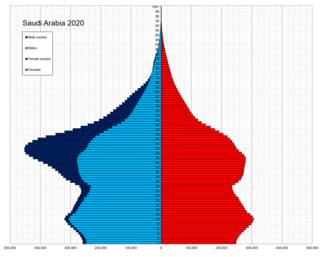
Saudi Arabia is the fourth largest state in the Arab world, with a reported population of 35,013,414 as of 2018. 38.3% of inhabitants are immigrants. Saudi Arabia has experienced a population explosion in the last 40 years, and continues to grow at a rate of 1.62% per year.
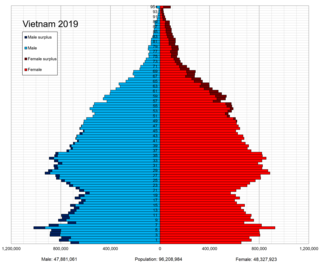
This article is about the demographic features of the population of Vietnam, including population density, ethnicity, education level, health of the populace, economic status, religious affiliations and other aspects of the population.
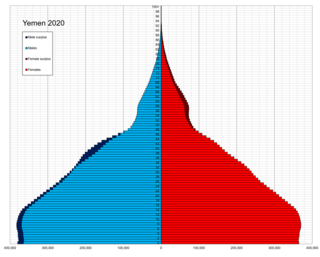
This article is about the demographic features of the population of Yemen, including population density, ethnicity, education level, health of the populace, economic status, religious affiliations and other aspects of the population.

Tunisia's population was estimated to be around 11.6 million in mid-2019. In the generally youthful African continent, Tunisia's population is among the most mature. This is because the government has supported a successful family planning program that has reduced the population growth rate to just over 1% per annum, contributing to Tunisia's economic and social stability. The population of Tunisia is primarily of Berber ancestral origin (>60%).

This is a demography of the population of Bahrain including population density, ethnicity, education level, health of the populace, economic status, religious affiliations and other aspects of the population.

Western Asia, West Asia, or Southwest Asia, is the westernmost subregion of the larger geographical region of Asia, as defined by some academics, UN bodies and other institutions. It is almost entirely a part of the Middle East, and includes Anatolia, the Arabian Peninsula, Iran, Mesopotamia, the Armenian Highlands, the Levant, the island of Cyprus, the Sinai Peninsula, and partly the Caucasus Region (Transcaucasia). The region is considered to be separated from Africa by the Isthmus of Suez in Egypt, and separated from Europe by the waterways of the Turkish Straits and the watershed of the Greater Caucasus. Central Asia lies to its northeast, while South Asia lies to its east. Eight seas surround the region (clockwise): the Aegean Sea, the Black Sea, the Caspian Sea, the Persian Gulf, the Arabian Sea, the Gulf of Aden, the Red Sea, and the Mediterranean Sea.
The United Nations Statistics Division (UNSD), formerly the United Nations Statistical Office, serves under the United Nations Department of Economic and Social Affairs (DESA) as the central mechanism within the Secretariat of the United Nations to supply the statistical needs and coordinating activities of the global statistical system. The Division is overseen by the United Nations Statistical Commission, established in 1947, as the apex entity of the global statistical system and highest decision making body for coordinating international statistical activities. It brings together the Chief Statisticians from member states from around the world.
Statistics Denmark is a Danish governmental organization under the Ministry of the Interior and Housing and which reports to the Minister of Economic and Internal Affairs. The organization is responsible for creating statistics on the Danish society, for example employment statistics, trade balance, and demographics.
Environment statistics is the application of statistical methods to environmental science. It covers procedures for dealing with questions concerning the natural environment in its undisturbed state, the interaction of humanity with the environment, and urban environments. The field of environmental statistics has seen rapid growth in the past few decades as a response to increasing concern over the environment in the public, organizational, and governmental sectors.

 Altar of Domitius Ahenobarbus
Altar of Domitius Ahenobarbus 









